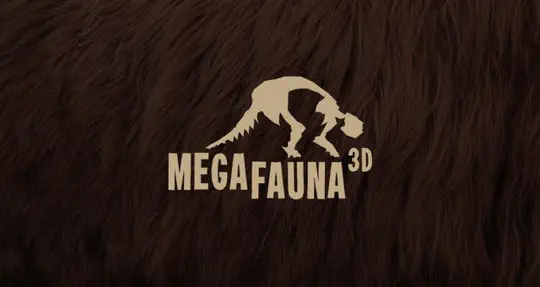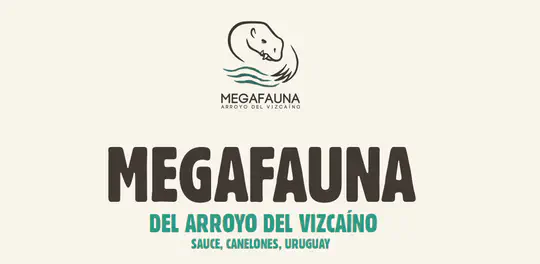Luciano Varela
Researcher studying xenarthran paleobiology
Facultad de Ciencias, Universidad de la República, Uruguay
Biography
I am a paleontologist from Uruguay, South America. I study macroevolutionary and macroecological aspects of fossil xenarthrans, one of the most important groups of the South American native megafauna. I also work using 3D models of fossil bones to answer various questions about these animals, like what they ate or how hard they bit. I am interested in the conservation and valorization of fossil collections and the use of new technologies in these activities.
- Fossil Mammals
- Xenarthra
- Paleoecology
- Extinctions
- Evolution
Ph.D., Biological Sciences, 2023
Facultad de Ciencias, Universidad de la República
M.Sc., Biological Sciences, specialization: Zoology, 2018
Facultad de Ciencias, Universidad de la República
B.Sc. (Hons), Biological Sciences, specialization: Paleontology, 2014
Facultad de Ciencias, Universidad de la República
Publications
Featured Publications

Understanding the role of megamammals in shaping terrestrial ecosystems and landscapes during the South American Late Pleistocene is crucial for estimating the impacts of extinctions on current ecological dynamics. Here, we aimed to investigate the mobility patterns and landscape use of the extinct giant ground sloth Lestodon armatus, a member of South America’s megafauna, where the Pleistocene extinction was the hardest. We report, to our knowledge, the first strontium isotope ratio (87Sr/86Sr) analysis for L. armatus, acquired from bone and dentin samples across six Uruguayan localities, including six individuals and serial sampling of a tooth from one of the sites. Our results show a highly localized 87Sr/86Sr signature for L. armatus in the study area, suggesting limited movement within a defined home range consistent with their body mass. These results rule out the existence of extensive seasonal migrations in this species. Finally, we complemented our isotopic results with a connectivity analysis to explore landscape connectivity in southern Uruguay during the Late Pleistocene. The results provide a baseline for studying the spatial ecology of megamammal communities in the region and expand the knowledge on how the extinction of large herbivores might have influenced landscape connectivity in South America during and after the Late Pleistocene.
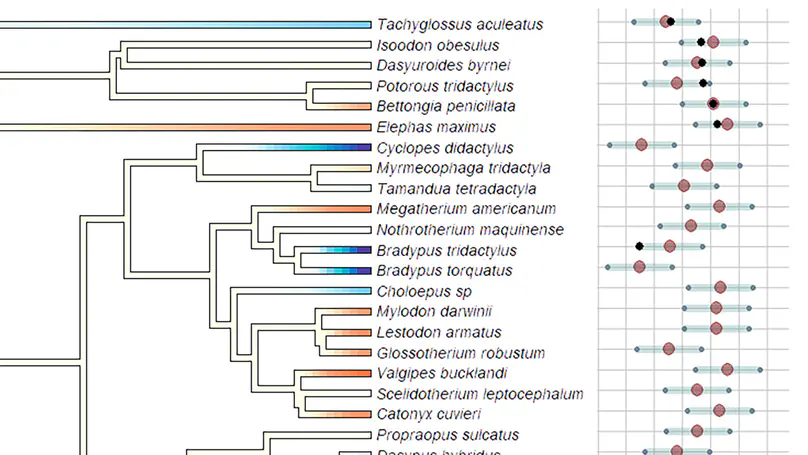
Nutrient foramina are small openings in the periosteal surface of the mid-shaft region of long bones that traverse the cortical layer and reach the medullary cavity. They are important for the delivery of nutrients and oxygen to bone tissue and are crucial for the repair and remodeling of bones over time. The nutrient foramina in the femur’s diaphysis are related to the energetic needs of the femur and have been shown to be related to the maximum metabolic rate (MMR) of taxa. Here, we investigate the relationship between nutrient foramen size and body mass as a proxy to the aerobic capacity of taxa in living and extinct xenarthrans, including living sloths, anteaters, and armadillos, as well as extinct xenarthrans such as glyptodonts, pampatheres, and ground sloths. Seventy femora were sampled, including 20 from extant taxa and 50 from extinct taxa. We obtained the blood flow rate (Q̇) based on foramina area and performed PGLS and phylogenetic ANCOVA in order to explore differences among mammalian groups. Our results show that, among mammals, taxa commonly associated with lower metabolism like living xenarthrans showed relatively smaller foramina, while the foramina of giant extinct xenarthrans like ground sloths and glyptodonts overlapped with non-xenarthran placentals. Consequently, Q̇ estimations indicated aerobic capacities comparable to other placental giant taxa like elephants or some ungulates. Furthermore, the estimation of the MMR for fossil giant taxa showed similar results, with almost all taxa showing high values except for those for which strong semi-arboreal or fossorial habits have been proposed. Moreover, the results are compatible with the diets predicted for extinct taxa, which indicate a strong consumption of grass similar to ungulates and in contrast to the folivorous or insectivorous diets of extant xenarthrans. The ancestral reconstruction of the MMR values indicated a lack of a common pattern for all xenarthrans, strongly supporting the occurrence of low metabolic rates in extant forms due to their particular dietary preferences and arboreal or fossorial habits. Our results highlight the importance of considering different evidence beyond the phylogenetic position of extinct taxa, especially when extinct forms are exceptionally different from their extant relatives. Future studies evaluating the energetic needs of giant extinct xenarthrans should not assume lower metabolic rates for these extinct animals based solely on their phylogenetic position and the observations on their extant relatives.
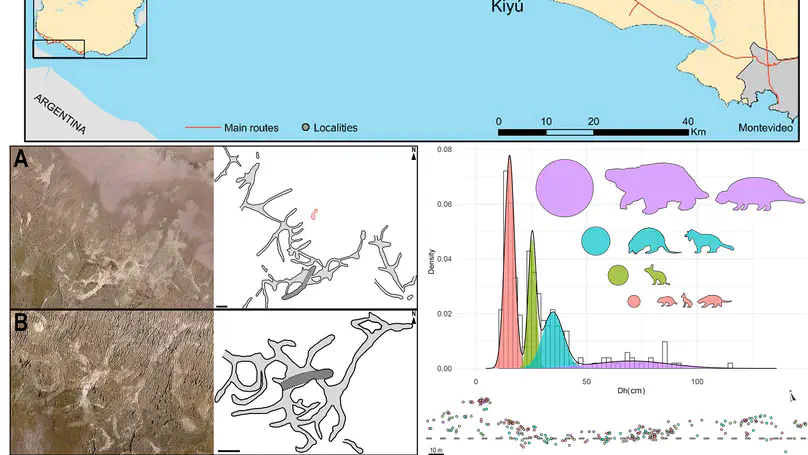
We report fossil mammal burrows from backshore beach facies in the Camacho Formation of southern Uruguay, of Late Miocene (Huayquerian SALMA) age. The presence of desiccation cracks and rhizoliths indicate the occurrence of relatively extended periods of subaerial exposure and the incipient development of vegetation. The analysis of the burrows’ spatial extent, size, and structure reveals the existence of exceptionally well-preserved and intercrossing tunnel systems. We show the existence of different size classes of burrows, which indicate that at least four different taxa were responsible for their construction. Considering the inferred body masses of the trace makers obtained from allometric relationships and the body masses of taxa recovered for the Camacho Formation, the burrows may have been produced by a combination of the following mammals: one of several rodents, notoungulates, cingulates, folivorans, and a carnivoran. The fossil association represents an exceptional case of a community of ecosystem engineers in the Late Miocene of southeastern South America.
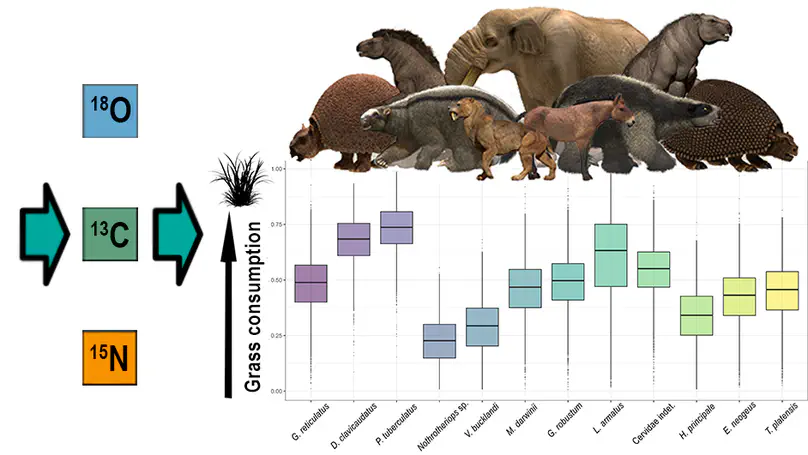
The analysis of stable isotopes on fossil mammals has become a widely used tool for understanding the paleoecology and paleodiet of these organisms. In this work, we study the stable isotope composition of collagen (δ13C and δ15N) and bioapatite (δ13C and δ18O) of fossil bones from Arroyo del Vizcaíno, a fossiliferous site in southern Uruguay dated to ∼32 ka cal BP. Fourteen taxa were analyzed: the ground sloths Lestodon armatus, Glossotherium robustum, Mylodon darwinii, Valgipes bucklandi and Nothrotheriops sp.; the glyptodonts Glyptodon reticulatus, Panochthus tuberculatus, and Doedicurus clavicaudatus; the equids Hippidion principale and Equus neogeus; the proboscidean Notiomastodon platensis; the notoungulate Toxodon platensis; the saber-tooth felid Smilodon populator; and an indeterminate cervid. In general, the percentage of nitrogen in collagen and the C:N ratio were within the limits expected for collagen preservation in fossil bone. The δ13C and δ15N results of the herbivores indicated that most taxa consumed high proportions of C3 plants in open, relatively dry environments, but significant variations were observed. Furthermore, relatively high values of δ18O in bone bioapatite, which approximately tracks local drinking water, indicated low precipitation and/or high evaporation. Our results show that the herbivorous taxa present at the site covered a considerable range of the grazer-browser spectrum and support the existence of niche partitioning among closely related taxa. Overall, these kinds of approaches are indispensable to better understand how these communities thrived during the Pleistocene in the region, supporting an outstanding number of giant species, before their extinction at the Pleistocene-Holocene transition.
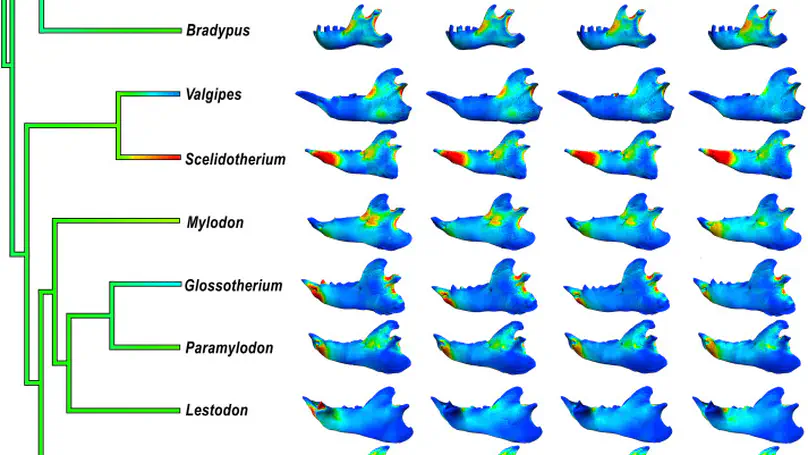
Sloths are represented today only by two distantly-related small, arboreal, and folivorous genera. However, the fossil record of the clade is composed of many more taxa, with much more diverse morphologies, including giant terrestrial forms with no clear modern analogs. In this context, several approaches have been implemented in order to explore the ecological adaptations of fossil taxa and, in particular, their dietary preferences. In this work we used 3D Finite Elements Analysis (FEA) coupled with Geometric Morphometrics (GMM) to explore the ecomorphology of sloths and possible differences among taxa related to dietary adaptations. Digital models of the mandibles of 14 taxa were obtained (two extant and twelve extinct), representing members of all the major clades within the group. We modeled the actions of the three major muscles involved in mastication (masseter, temporalis, and pterygoideus) and simulated unilateral mastication in four different conditions, one for each tooth along the toothrow. The results were analyzed qualitatively regarding the distribution of von Mises stress (vMs) and quantitatively using the mesh-weighted arithmetic mean (MWAM) vMs, strain energy (SE), and mechanical efficiency (ME). Differences in the distribution of high-vMs areas and lower SE values were found among taxa predicted to be grazers in comparison to those predicted to be browsers. Furthermore, when simulating biting with the most anterior tooth, we observed considerably higher vMs and SE values in taxa with a caniniform, which could indicate its involvement in sexual display rather than in food processing, acquisition, or other strenuous activities.
Projects
Contact
- lvarela[at]fcien.edu.uy
- Iguá 4225, Montevideo, 1400
- DM Me
